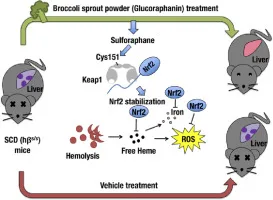What is Sulforaphane?
Sulforaphane is a naturally occurring isothiocyanate compound found primarily in cruciferous vegetables such as broccoli, kale, Brussels sprouts, and cabbage. When these vegetables are chopped, chewed, or crushed, an enzyme called myrosinase converts glucoraphanin (a precursor molecule) into sulforaphane. This compound is renowned for its potent antioxidant, anti-inflammatory, and detoxifying properties, making it a popular subject in nutritional and medical research. Sulforaphane supplements are also available, often derived from concentrated broccoli sprout extracts, offering a convenient way to harness its health benefits.
Benefits and Actions of Sulforaphane
- Powerful Antioxidant Defense
- Activates the Nrf2 pathway, triggering the production of endogenous antioxidants (e.g., glutathione) that neutralize free radicals and protect cells from oxidative stress. This may reduce the risk of chronic diseases like heart disease, Alzheimer’s, and cancer.
- Anti-Inflammatory Effects
- Suppresses the activation of pro-inflammatory pathways (e.g., NF-κB), decreasing the production of cytokines and enzymes linked to inflammation. Benefits conditions such as arthritis, inflammatory bowel disease (IBD), and metabolic syndrome.
- Cancer Prevention and Treatment Support
- Induces apoptosis (programmed cell death) in cancer cells, inhibits tumor growth, and blocks angiogenesis. Studies suggest efficacy against prostate, breast, lung, and colon cancers, though more research is needed for clinical applications.
- Detoxification Enhancement
- Stimulates Phase II detoxification enzymes in the liver, aiding the elimination of toxins, carcinogens, and pollutants from the body.
- Heart Health Promotion
- Improves endothelial function, reduces LDL cholesterol oxidation, and lowers blood pressure, contributing to overall cardiovascular health.
- Gut Microbiome Modulation
- Nurtures beneficial gut bacteria while inhibiting pathogens, potentially improving digestion and immune function.

How to Take Sulforaphane? Daily Dosage
- Food Sources: Consume cruciferous vegetables raw or lightly steamed (to preserve myrosinase activity). Aim for 2–3 servings (1–2 cups) daily, such as:
- 1 cup of broccoli florets provides ~20–80 mg of glucoraphanin (convertible to sulforaphane).
- Supplements:
- Capsules/Tablets: Standard doses range from 50–200 mg of sulforaphane per day. Start with 50 mg and gradually increase if tolerated.
- Liquid Extracts: Follow product instructions, typically 1–2 mL (equivalent to 100–150 mg) daily.
- समय: Take supplements with food to enhance absorption. For best results, combine with a source of healthy fats (e.g., olive oil, avocado).
Side Effects & Precautions
- सामान्य दुष्प्रभाव:
- Gastrointestinal: Mild gas, bloating, or diarrhea may occur, especially at high doses or in individuals with sensitive stomachs.
- Interactions: May interact with certain medications metabolized by the liver (e.g., blood thinners, statins); consult a doctor before use.
- मतभेद:
- गर्भावस्था/स्तनपान: Insufficient safety data; avoid high-dose supplements.
- Thyroid Conditions: Cruciferous vegetables can interfere with iodine uptake. If hypothyroid, balance intake with iodine-rich foods or consult a dietitian.
- एलर्जी प्रतिक्रियाएं: Rare, but discontinue use if skin rashes, swelling, or breathing difficulties occur.
Optimal Dosing Protocol
- Gradual Increase: Begin with low doses (e.g., 50 mg/day) and monitor tolerance for 1–2 weeks before increasing.
- Long-Term Use: Safe for daily consumption at recommended levels. For therapeutic benefits (e.g., cancer prevention), doses up to 200 mg/day may be appropriate under medical supervision.
- Combination Therapy: Enhance sulforaphane’s effects by pairing with other antioxidants (e.g., vitamin C, E) or anti-inflammatory compounds (e.g., curcumin).
Where to Purchase Sulforaphane Products?
- For high-quality sulforaphane supplements:
- Official Website: aiherba.com offers GMP-certified products with verified sulforaphane content.
- Health Food Stores: Look for brands with third-party testing (e.g., USP, NSF) and clear dosage information.
- Online Retailers: Choose reputable sellers with customer reviews and return policies.
- Inquiries: Contact via email at liaodaohai@gmail.com for product details, usage guidance, or bulk orders.

निष्कर्ष
Sulforaphane stands out as a versatile nutrient with far-reaching health benefits, from antioxidant protection to disease prevention. Incorporating cruciferous vegetables into your diet is a natural way to access sulforaphane, while supplements offer convenience for targeted support. However, like any dietary addition, it’s crucial to start slowly, monitor for side effects, and consult a healthcare provider—especially if taking medications or managing health conditions. Ensure product quality by purchasing from trusted sources like aiherba.com to maximize safety and efficacy.
संदर्भ
- Fahey, J. W., et al. (2002). Sulforaphane inhibits extracellular, intracellular, and antibiotic-resistant strains of Helicobacter pylori and prevents benzo[a]pyrene-induced stomach tumors. PNAS, 99(11), 7610–7615.
- Zhang, Y. (2004). Multifunctional roles of sulforaphane in cancer prevention. कैंसर पत्र, 202(2), 155–164.
- Chinese Pharmacopoeia Commission. (2020). Pharmacopoeia of the People’s Republic of China (Vol. 1). Beijing: China Medical Science Press.
- World Health Organization. (2019). Guidelines on Dietary Supplements: Safety and Quality. Geneva: WHO Press.
- National Center for Biotechnology Information. (2023). Sulforaphane – Health Effects. Retrieved from PubMed.
